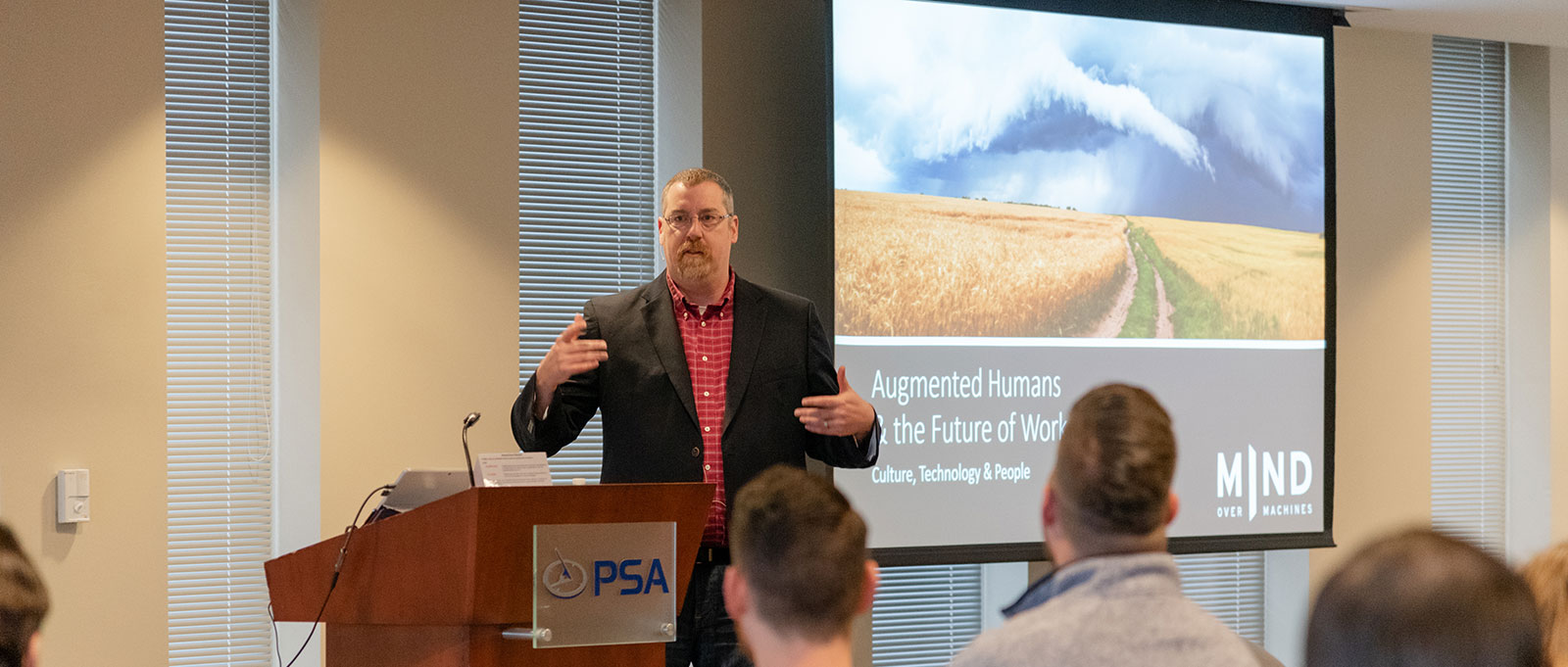Are robots and artificial intelligence taking over the world? Technology is evolving more rapidly than ever, and the need to leverage technology for business success has become imperative for C-level executives across all industries. However, talk of artificial intelligence, robotics, and machine learning is prompting thoughts and fears in the minds of many business owners and employees surrounding the costs of investing in new technologies and the possibility of layoffs due to job automation.
Tim Kulp, Director of the Emerging Technologies Practice at Mind Over Machines, discussed at our January Partnership event the major social, cultural, and technological shifts in the workplace. As Tim mentioned, according to data from The Future of Jobs 2018 by the World Economic Forum, while 75 million jobs were displaced by automation, 133 million new jobs were created by automation. The truth is, our current landscape is changing, but it’s not because of technology. People, enabled by technology, are changing our culture.
Tim took us back in time to reflect on ice harvesters, who used to cut and gather ice from natural sources and then sell it to keep food cold. Eventually, this way of business gave way to refrigeration companies who leveraged technology, leaving the ice harvesting occupation obsolete. This story of evolution is ongoing throughout all time and in all areas of business.
[psa_quote]As a business executive, you can be a leader of this cultural change by leveraging technology, or you can watch as changes happen to you—which path will you choose? How will you become the refrigeration company in a climate of change before you’re left behind as an ice harvester?[/psa_quote]
Embrace the New Reality
Technology is impacting all areas of life, from social, to hobbies, to work. Never before could you make money using your personal vehicle as a driving service summoned by a smartphone, or turn teaching programs and techniques via a YouTube channel into your full-time career. Uber, online side hustles, social media…all of these shifts are a result of people enabled by technology.
Consequently, all areas of life intersecting with technology can distract your employees from accomplishing your company goals. Whether you like it or not, these interruptions are everywhere, and embracing them and adjusting in order to benefit from the changes is key to business success. Here are two examples of shifts due to technology that impacted the business world, and how the business world has progressed from rejecting the idea to making the best of the situation.
- Facebook
Most companies were quick to dismiss Facebook and banned it from workplace computers. With the development of smartphones, however, it was hard for employers to control whether or not employees used the Facebook app throughout the workday. Now, most successful companies have gone from banning social media at work to creating jobs which strategically use social media for marketing, e-commerce, and branding.
- Cybercrime
We’ve moved from companies refusing to believe that they would ever be targets of cybercrime to recognizing the necessity of protecting against inevitable threats. Companies are now investing in tools, training, and insurance policies to help them recover quickly and affordably from unavoidable cyber incidents.
Ways to Leverage Technology
- Artificial intelligence (AI)
Leverage AI, if appropriate for your business, to allow you to focus on more strategic initiatives while also building deeper human relationships with your colleagues. AI can alleviate the burden of doing certain mundane or repetitive tasks, such as monitoring worksites or supplementing human interactions in customer service via online chatbots.
- Business intelligence (BI)
Invest in a few key platforms, such as a customer relationship management system, a marketing automation tool, and website analytics. If you already have these systems, don’t just store collected data there—instead, use BI to analyze it and turn it into actionable insights. Gain a better understanding of your customer interactions through data points, such as activity history of contacts, accounts, and workflows, to improve your business strategy.
Integrating Technology with Your Workforce for Organizational Success
When you introduce new technology, you may also eliminate some human jobs. How are you equipping your people to do the new jobs created by automation? Here are two ways to help your workforce adjust and thrive:
- As leaders, “skilling up” your employees is a vital responsibility. When we know that change is inevitable and that new skills will be necessary to evolve, we must constantly invest in the growth and training of employees, so they are able to take on new responsibilities.
- With the advancement of technology, the concept of work-life balance has changed and become more challenging to achieve. Work can bleed into all areas of life at all times. Strive to create win-win opportunities for both your business and your employees.
You may be surprised to hear a technologist say this, but Tim advises that you will never be able to keep up with the constant new and changing technology—stop trying. Technology should not drive your business, people do. But technology should inspire your business.
In order to survive and thrive, you need to see the changing trends and adjust accordingly. How does or could technology enable you? Find out where your human workforce brings value, and then invest only in a few, key technologies that support and enhance those areas.
Learn More from PSA
Interested in attending our next Partnership seminar? Make sure to register for our March event, “Leadership Language” presented by Chalmers Brothers, best-selling author, certified executive coach, and international speaker on March 26.




